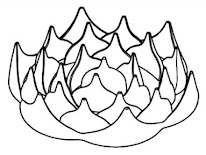Lotus-Shaped Acupressure Mat Product Design Lacks Acquired Distinctiveness and Fails to Function as a Service Mark
The Board affirmed refusals to register the product design shown below as a trademark for acupressure mats and pillows, and as a service mark for retail store services featuring those goods, finding that the product shape lacked acquired distinctiveness as a trademark and failed to function as a service mark. The mark comprises "a three-dimensional configuration comprising a stylized lotus flower." This blog post will attempt to hit the high points of the 75-page decision. In re PTM Guard, SIA, Serial No. 79248407 (August 22, 2022) [not precedential] (Opinion by Judge Christopher Larkin).
Acquired Distinctiveness: The record showed that "the lotus configuration appears in a repeating arrangement on applicant’s goods and each single lotus configuration serves as an acupressure apparatus which collectively produces a massaging effect when applicant’s goods are in use." Because a product configuration cannot be inherently distinctive, the sole issue was whether the proposed mark had acquired distinctiveness.
The Board discussed at length the applicant's evidence, applying the Converse factors. The record showed "a substantial number of mats and pillows embodying lotus designs that are nearly identical in appearance to Applicant’s design." As to the applicant's advertising, most did "little more than show the products, and they do not establish that consumers associate the features of the applied-for mark with Applicant." Some did display an individual lotus flower, but there was nothing “that directs [Applicant’s] potential consumer in no uncertain terms to look for a certain feature to know that it is from that source."
Applicant's sales figures lacked competitive contextual information. There was no evidence or testimony to support Applicant's supposed enforcement efforts. And with regard to unsolicited media coverage, what little there was made virtually no mention of the lotus shape as a source identifier.
Based on a consideration of all the evidence properly in the record, the Board found that applicant fell "far short of showing" that its design has acquired distinctiveness within the meaning of Section 2(f) of the Trademark Act.
Failure-to-Function: In determining whether the proposed mark functions as a service mark, the crucial issue is the commercial impression that the product design makes on the relevant public: would it be perceived as a source indicator?
Here, the claimed service mark appears on social media pages through which Applicant appears to provide online retail store services “featuring . . . acupressure mats, acupressure pillows” and other goods. Consumers viewing Applicant’s use of its claimed service mark on these pages, on which goods embodying the design are shown, are more likely to view the claimed service mark as a close-up depiction of a feature of the goods than as an identifier of the source of the services of selling them.
And so, the Board affirmed both refusals.
Read comments and post your comment here.
TTABlogger comment: Can you think of a product shape that functions as a service mark for retail store services offering that product? Maybe a food item for restaurant services?
Text Copyright John L. Welch 2022.



3 Comments:
I wonder why the examining attorney didn’t press functionality. When, as in this case, competing products use the same or similar features, that’s evidence of functionality. See In re Becton, Dickinson and Co., 675 F.3d 1368 (Fed. Cir. 2012); In re Honeywell, Inc., 532 F.2d 180 (C.C.P.A. 1976); Mine Safety Appliances Co. v. Elec. Storage Battery Co., 405 F.2d 901 (C.C.P.A. 1969).
The quality and quantity of the evidence was very relevant, as it should be. The Failure-to-Function point is crucial - the salient point.
As for the question regarding the capacity of a product to act as a service mark for retail store services offering the product, it is difficult to conceive of such a situation as, for one thing, the product would have to have acquired a reputation in its own right to be able to act as a trademark. Perhaps the shape of the Toblerone chocolate bar could act as a servioce mark for a retail store selling Toblerone-related products, but not limited to the chocolate bars.
2183417 ? Not a services class, but there are related filings for services featuring a depiction of the shape.
Post a Comment
<< Home